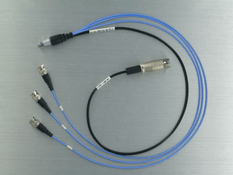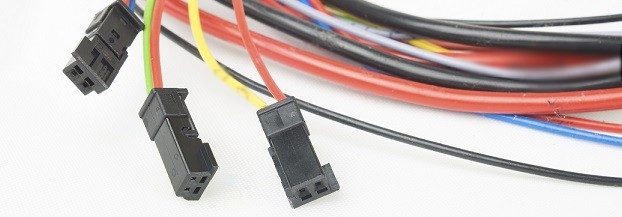Cable assemblies and wire harnesses are often confused for being the same thing.
The confusion is understandable since many professionals use the terms interchangeably and the products themselves have very similar basic functions. Yet these products are very different from each other, as is their purpose, which means definitions need to be made in order to help people get the products they need. This is a brief explanation of cable assembly vs. wire harness, and how each product is used out in the world.
Cable Assembly vs. Wire Harness
Before getting into the fighting differences of a cable assembly vs. wire harness, it’s important to note the difference between wire and cable, since these terms are also used interchangeably despite being very different products. Essentially, a wire is a strand of material that conducts electricity, such as aluminum or copper. A cable, by contrast, is two or more wires that run together. They’re often bonded or braided together, which is why you see cables that look like bunches of intertwined wires.
The Wire Harness
At their most basic, wire harne sses are a simple exterior sheath that covers some wires or cables. It’s usually made of thermoplastic or thermoset material which helps protect the wires from their environment. For the most part, wire harnesses bundle up cables and wires that are already protected by their own exterior sheaths. That means you could open up a wire harness and see multiple cables with their own coverings, but they’re all in a single wire harness.
sses are a simple exterior sheath that covers some wires or cables. It’s usually made of thermoplastic or thermoset material which helps protect the wires from their environment. For the most part, wire harnesses bundle up cables and wires that are already protected by their own exterior sheaths. That means you could open up a wire harness and see multiple cables with their own coverings, but they’re all in a single wire harness.
Wire harnesses are a low-cost electrical solution that’s best for keeping electrical systems organized. By bundling wires and cables together, engineers and electrical contractors can keep their wiring systems organized. Since wire harnesses are often a low cost organizational tool, they aren’t generally able to protect the wires inside from constant friction, temperature swings, or other factors that could cause damage to the wires inside the harness.
The Cable Assembly
Cable assemblies are a group of wires or cables covered by a much more intensive exterior product. In general, they are made from heavy-duty materials, including shrink-wrapped thermoplastic, thermoplastic rubber, or vinyl. These assemblies serve a similar function to wire harnesses, including keeping wires and cables organized, but are designed for entirely different environments.
Cable assemblies are designed for specific environmental factors, including the size of the area where it’s being used and the types of environmental factors it’s likely to encounter. For this reason, cable assemblies can come in many different shapes and sizes, and are built to shield the interior wires and cables from heat, friction, moisture, abrasion, compression, and other hazards.
So what’s the difference between wire harnesses and cable assemblies? Well, each is used in different environments. Wire harnesses offer a low-cost solution for keeping wires organized, while cable assemblies keep all of the products safe in the most extreme circumstances.
If you’re looking for tough, quality cable assemblies and wire harnesses, Meridian Cable can get you the exact kind of product you need.
Cable Assembly vs. Wire Harness FAQs
What is a wire harness?
A wire harness is a bundle of wires or cables that utilizes low cost elements to contain its components together in an organized and efficient manner. A wire harness will typically utilize a sheath material like thermoplastic that provides some protection for its internal wires and cables but for the most part these components will already have their own protective sheathing, minimizing the need for additional protective measures.
What is a wiring harness used for?
Wiring harnesses solve two essential problems within an electrical system – geometric limitations and electrical requirements. Wiring harnesses help provide the physical support system for cables and wires to be employed within a very specific space, in an organized, and protected manner. Wiring harnesses are used in a variety of applications from airplane engines to commercial and residential electrical wiring. Wiring harnesses provide a low-cost solution for organizing and protecting a specific group of cables and wires within a system.
Why are wire harness & cable assembly often confused?
By nature, both wire harnesses and cable assemblies contain cables and wires. The main difference is in the engineering of the component to match the application. Wire harnesses are low-cost means with which to provide a bundle of cables and wires some degree of protection, while keeping them organized for ease of installation and future service. Cable assemblies provide a much more robust protection by keeping components snug within a rugged outer sheath. Cable assemblies are meant to be used in demanding environments where things like heat, friction, or moisture could prematurely wear out a cable or wire.
What is the difference between a wire and a cable?
The core of the differentiation between wire harnesses and cable assemblies lies in the fact that wires and cables are two entirely separate things. A wire is a single strand of a conductive material like tin or copper. Once a bundle of wires are twisted or braided together and contained within a protective outer sheath, they have become a cable.
How are wire harnesses made?
Wire harnesses go through many stages of design and manufacturing before a concept is ready for in-field use. First, our brilliant design team will meet with the client to determine the specs of the project. The design team use tools like computer aided drafting programs to produce the measurements for the necessary components of the system.
Once design elements are finalized, we move on to prototyping. Prototyping allows us to produce multiple iterations of the proposed design. After several rounds of testing from automated testing machines like our Cerrus units, these prototypes will progress into our “life lab” where the components will be subjected to real-world conditions and continually evaluated for functionality, durability, and, above all, safety. Prototyping also affords our design staff the time to see if different source materials will be viable logistically. If a certain elements don’t arrive in an efficient and economically viable manner, it can throw off the whole manufacturing process and increase expenses. Prototyping allows for any logistical hurdles to be worked out ahead of production runs so the process can proceed as smoothly as possible. The prototype iteration will also help our production team know which tools will need to be reserved from our custom tool crib.
Once all of these elements have been smoothed out, the unit will progress into volume production, final testing, and ultimately, distribution to their intended destinations. With production facilities located in both the US and in China, we’re able to quickly get our products to customers around the world.
How can wire harnesses offer a low-cost solution for keeping wires organized?
Wire harnesses can help group together specific sets of wires and cables within a system that are intended to serve a different purpose. Within an industrial control system like those that automate a manufacturing process, a multitude of different cables and wires will generate the necessary signals, data, and power that runs the system’s many moving parts. Because they are not made to have to withstand the same external pressures as a cable assembly, a wiring harness helps engineers and contractors to cost-effectively keep everything efficient and organized within the space.
What is the definition of cable assembly?
A cable assembly is:
a collection of cables or wires;
includes wiring of different gauges that can be stranded or braided;
is wrapped in an insulating material;
is provided with appropriate fillers for the environment like Kevlar or nylon;
is jacketed in a durable exterior layer acting as a final insulator, shield, and protective cover;
provides superior protection to its components and so is meant for demanding environments such as heavy industry and those experienced by our men and women in uniform.
How can cable assemblies keep all of the products safe in the most extreme circumstances?
Cable assemblies are groups of wires and cables that have been covered from a really heavy-duty material like shrinkwrapped thermoplastic or vinyl. Cable assemblies are matched to the environment in both size requirement and ability to provide protection to their interior cables from things like water, extreme heat and cold, friction, and oxidation. Punishing applications such as those experienced by our men and women in uniform often include some of the most rugged environments on the planet with extremely high usage rates. This combination of strength and durability is an intense design challenge when working in a confined environment but our engineers love solving complex problems. Contact our knowledgeable sales team today to get your project’s cable assembly design started.
Is a wire harness different than an electrical harness?
There is no difference, a wire harness is called many different names, including cable assembly, cable harness, and wiring assembly. It is a common misconception that cable assemblies and wiring harnesses are one and the same. In fact, these two components play separate and distinct roles within an electrical system.
What do you call a bundle of wires?
A bundle of wires graduates from being individual strands of a conductor into being a unified piece of cable. Cables are usually braided or twisted strands of conductor that’s then sheathed in a protective material like thermoplastic. Ready for a creative solution for your cable and wiring needs? Contact a sales specialist today.
What is a tooling inventory within the wire harness assembly process?
The tooling inventory plays an absolutely vital role within the production process. After more than 30 decades in the business, we’ve amassed more than 5,000 tools for different connectors, junctions, overmolds, and housings. If we don’t have an existing tool to meet the needs of the project, our brilliant in-house design team can produce it from scratch. Before a production run is made, a process engineers physically “check-out” all of the different tools that will be required to manufacture the product.
Why is UL certification important with cable assemblies and wiring harnesses?
Underwriters Laboratories (UL) is an independent testing service authorized by the US government to perform product and processes testing for safety, functionality, and adherence to the design standards. We are proud to be a UL-approved facility for manufacturing and utilize UL-certified cables and wires within all of our cable assemblies and wiring harnesses. By having a cable or wire of preknown specifications and viability, our engineers can confidently employ these solutions without having to develop a new one on the spot.
How complex is wire harness manufacturing?
Sometimes, our designs are fairly simple – like two wires bound together with some basic terminals attached to the end. But other projects require an incredibly complex design incorporating a variety of different conductors, connectors, terminations, sheathing, overmolds, grommets, and/or strain relief. Taking all of these design elements into consideration, our brilliant in-house engineers produce a perfect design for the application that’s both functional and economical. Contact our team to get your project started. Meridian Cable has been in the wire harness manufacturing business for over 25 years.